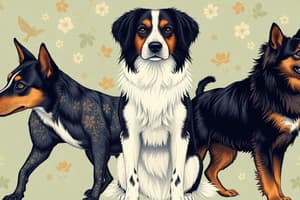Podcast
Questions and Answers
Which group of dog breeds is primarily bred for hunting and retrieving?
Which group of dog breeds is primarily bred for hunting and retrieving?
- Hound Group
- Terrier Group
- Working Group
- Sporting Group (correct)
What size category does the Bulldog fall into?
What size category does the Bulldog fall into?
- Medium Breeds (correct)
- Large Breeds
- Toy Breeds
- Small Breeds
Which breed is known for being intelligent and often used in police and service roles?
Which breed is known for being intelligent and often used in police and service roles?
- Cocker Spaniel
- German Shepherd (correct)
- Beagle
- Labrador Retriever
Which of the following is a characteristic to consider when choosing a dog breed?
Which of the following is a characteristic to consider when choosing a dog breed?
What common health issue is larger dog breeds prone to?
What common health issue is larger dog breeds prone to?
Which group includes small companion breeds such as the Chihuahua and Pomeranian?
Which group includes small companion breeds such as the Chihuahua and Pomeranian?
What is a key factor for active dog breeds in terms of care?
What is a key factor for active dog breeds in terms of care?
Which breed is often recognized for its loose, wrinkled skin and gentle nature?
Which breed is often recognized for its loose, wrinkled skin and gentle nature?
Flashcards are hidden until you start studying
Study Notes
Dog Breeds Overview
- Dogs are categorized into various breeds based on characteristics, size, and purpose.
Classification of Dog Breeds
-
Sporting Group
- Bred for hunting and retrieving.
- Examples: Labrador Retriever, Golden Retriever, Cocker Spaniel.
-
Hound Group
- Bred for tracking and hunting.
- Examples: Beagle, Bloodhound, Dachshund.
-
Working Group
- Bred for specific tasks like guarding and rescue.
- Examples: Boxer, Rottweiler, Siberian Husky.
-
Terrier Group
- Bred for hunting vermin and as companions.
- Examples: Jack Russell Terrier, Bull Terrier, Scottish Terrier.
-
Toy Group
- Small breeds, often kept as companions.
- Examples: Chihuahua, Pomeranian, Shih Tzu.
-
Non-Sporting Group
- Diverse group with varied characteristics.
- Examples: Bulldog, Dalmatian, Poodle.
-
Herding Group
- Bred to herd livestock and manage animals.
- Examples: German Shepherd, Border Collie, Australian Shepherd.
Size Categories
- Small Breeds: Typically under 20 pounds (e.g., Pomeranian, Dachshund).
- Medium Breeds: 20-60 pounds (e.g., Bulldog, Beagle).
- Large Breeds: Over 60 pounds (e.g., Labrador Retriever, Rottweiler).
Key Characteristics to Consider
- Temperament: Varies widely among breeds; consider energy level, trainability, and sociability.
- Grooming Needs: Short-haired vs. long-haired breeds require different grooming.
- Health Concerns: Certain breeds are prone to specific health issues (e.g., hip dysplasia in larger breeds, respiratory issues in brachycephalic breeds).
- Exercise Requirements: Active breeds need more exercise; sedentary breeds may adapt to less.
Popular Breeds
- Labrador Retriever: Friendly, outgoing, and high-energy; great family dogs.
- German Shepherd: Intelligent, versatile; often used in police and service roles.
- Bulldog: Gentle and affectionate; known for their loose, wrinkled skin.
- Poodle: Highly intelligent and hypoallergenic; comes in standard, miniature, and toy sizes.
Adoption and Breeding
- Consider adopting from shelters or rescues.
- Responsible breeding practices ensure the health and welfare of dogs.
Conclusion
- Understanding different dog breeds helps potential owners choose a suitable companion based on lifestyle, preferences, and needs.
Dog Breeds Overview
- Dogs are categorized into various breeds based on traits, size, and intended use.
Classification of Dog Breeds
- Sporting Group: Bred for hunting and retrieving; includes Labrador Retriever, Golden Retriever, and Cocker Spaniel.
- Hound Group: Focused on tracking and hunting; notable breeds are Beagle, Bloodhound, and Dachshund.
- Working Group: Designed for tasks like guarding and rescue; examples include Boxer, Rottweiler, and Siberian Husky.
- Terrier Group: Initially bred for vermin hunting and companionship; includes Jack Russell Terrier, Bull Terrier, and Scottish Terrier.
- Toy Group: Small breeds primarily kept as companions; examples are Chihuahua, Pomeranian, and Shih Tzu.
- Non-Sporting Group: A diverse category with various characteristics; includes Bulldog, Dalmatian, and Poodle.
- Herding Group: Bred to manage livestock; includes German Shepherd, Border Collie, and Australian Shepherd.
Size Categories
- Small Breeds: Generally weigh under 20 pounds; examples are Pomeranian and Dachshund.
- Medium Breeds: Weigh between 20-60 pounds, such as Bulldog and Beagle.
- Large Breeds: Weigh over 60 pounds; notable examples include Labrador Retriever and Rottweiler.
Key Characteristics to Consider
- Temperament: Varies widely; important to assess energy, trainability, and sociability.
- Grooming Needs: Differentiates between short-haired and long-haired breeds, affecting maintenance levels.
- Health Concerns: Some breeds have specific health issues; hip dysplasia is common in large breeds, while brachycephalic breeds may face respiratory problems.
- Exercise Requirements: Active breeds necessitate more exercise, while sedentary breeds adjust to lesser activity.
Popular Breeds
- Labrador Retriever: Known for being friendly, high-energy, and excellent family pets.
- German Shepherd: Valued for intelligence and versatility; frequently utilized in police and service capacities.
- Bulldog: Characterized as gentle and affectionate with distinct loose, wrinkled skin.
- Poodle: Recognized for high intelligence and hypoallergenic properties; available in standard, miniature, and toy sizes.
Adoption and Breeding
- Encouragement of adoption from shelters and rescues for responsible dog ownership.
- Emphasis on ethical breeding practices to promote dogs' health and welfare.
Conclusion
- Knowledge of different dog breeds aids prospective owners in selecting a suitable pet based on lifestyle and needs.
Studying That Suits You
Use AI to generate personalized quizzes and flashcards to suit your learning preferences.



